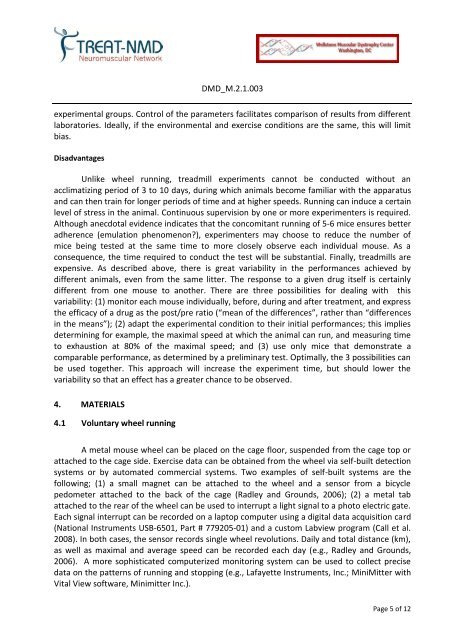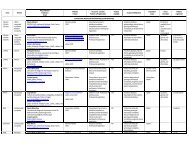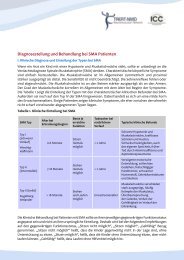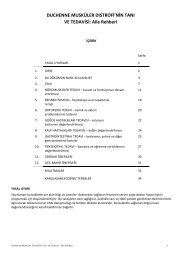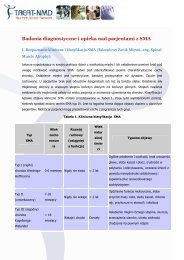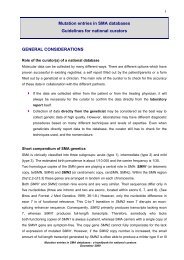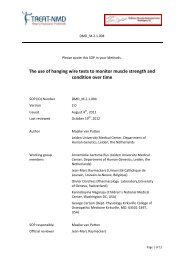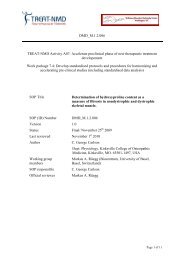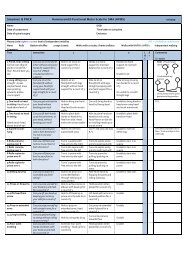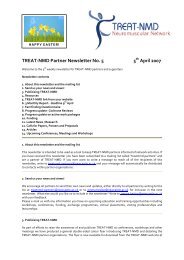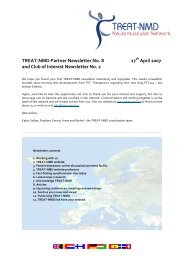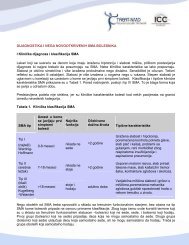Use of treadmill and wheel exercise to assess ... - Treat-NMD
Use of treadmill and wheel exercise to assess ... - Treat-NMD
Use of treadmill and wheel exercise to assess ... - Treat-NMD
Create successful ePaper yourself
Turn your PDF publications into a flip-book with our unique Google optimized e-Paper software.
DMD_M.2.1.003<br />
experimental groups. Control <strong>of</strong> the parameters facilitates comparison <strong>of</strong> results from different<br />
labora<strong>to</strong>ries. Ideally, if the environmental <strong>and</strong> <strong>exercise</strong> conditions are the same, this will limit<br />
bias.<br />
Disadvantages<br />
Unlike <strong>wheel</strong> running, <strong>treadmill</strong> experiments cannot be conducted without an<br />
acclimatizing period <strong>of</strong> 3 <strong>to</strong> 10 days, during which animals become familiar with the apparatus<br />
<strong>and</strong> can then train for longer periods <strong>of</strong> time <strong>and</strong> at higher speeds. Running can induce a certain<br />
level <strong>of</strong> stress in the animal. Continuous supervision by one or more experimenters is required.<br />
Although anecdotal evidence indicates that the concomitant running <strong>of</strong> 5-6 mice ensures better<br />
adherence (emulation phenomenon?), experimenters may choose <strong>to</strong> reduce the number <strong>of</strong><br />
mice being tested at the same time <strong>to</strong> more closely observe each individual mouse. As a<br />
consequence, the time required <strong>to</strong> conduct the test will be substantial. Finally, <strong>treadmill</strong>s are<br />
expensive. As described above, there is great variability in the performances achieved by<br />
different animals, even from the same litter. The response <strong>to</strong> a given drug itself is certainly<br />
different from one mouse <strong>to</strong> another. There are three possibilities for dealing with this<br />
variability: (1) moni<strong>to</strong>r each mouse individually, before, during <strong>and</strong> after treatment, <strong>and</strong> express<br />
the efficacy <strong>of</strong> a drug as the post/pre ratio (“mean <strong>of</strong> the differences”, rather than “differences<br />
in the means”); (2) adapt the experimental condition <strong>to</strong> their initial performances; this implies<br />
determining for example, the maximal speed at which the animal can run, <strong>and</strong> measuring time<br />
<strong>to</strong> exhaustion at 80% <strong>of</strong> the maximal speed; <strong>and</strong> (3) use only mice that demonstrate a<br />
comparable performance, as determined by a preliminary test. Optimally, the 3 possibilities can<br />
be used <strong>to</strong>gether. This approach will increase the experiment time, but should lower the<br />
variability so that an effect has a greater chance <strong>to</strong> be observed.<br />
4. MATERIALS<br />
4.1 Voluntary <strong>wheel</strong> running<br />
A metal mouse <strong>wheel</strong> can be placed on the cage floor, suspended from the cage <strong>to</strong>p or<br />
attached <strong>to</strong> the cage side. Exercise data can be obtained from the <strong>wheel</strong> via self-built detection<br />
systems or by au<strong>to</strong>mated commercial systems. Two examples <strong>of</strong> self-built systems are the<br />
following; (1) a small magnet can be attached <strong>to</strong> the <strong>wheel</strong> <strong>and</strong> a sensor from a bicycle<br />
pedometer attached <strong>to</strong> the back <strong>of</strong> the cage (Radley <strong>and</strong> Grounds, 2006); (2) a metal tab<br />
attached <strong>to</strong> the rear <strong>of</strong> the <strong>wheel</strong> can be used <strong>to</strong> interrupt a light signal <strong>to</strong> a pho<strong>to</strong> electric gate.<br />
Each signal interrupt can be recorded on a lap<strong>to</strong>p computer using a digital data acquisition card<br />
(National Instruments USB-6501, Part # 779205-01) <strong>and</strong> a cus<strong>to</strong>m Labview program (Call et al.<br />
2008). In both cases, the sensor records single <strong>wheel</strong> revolutions. Daily <strong>and</strong> <strong>to</strong>tal distance (km),<br />
as well as maximal <strong>and</strong> average speed can be recorded each day (e.g., Radley <strong>and</strong> Grounds,<br />
2006). A more sophisticated computerized moni<strong>to</strong>ring system can be used <strong>to</strong> collect precise<br />
data on the patterns <strong>of</strong> running <strong>and</strong> s<strong>to</strong>pping (e.g., Lafayette Instruments, Inc.; MiniMitter with<br />
Vital View s<strong>of</strong>tware, Minimitter Inc.).<br />
Page 5 <strong>of</strong> 12


